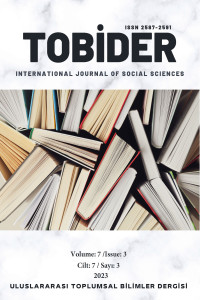Abstract
Çeviribilim alanında eşdeğerlik kavramı, değişen tanımları ve yaklaşımlar nedeniyle sık sık bir tartışma konusu olmuştur. Alanda çalışan isimler çeviriye dair bakış açıları çerçevesinde farklı eşdeğerlik anlayışları ortaya koymuştur. Bu makalede eşdeğerlik kavramının tarihsel bağlamı ve Çeviribilim alanının gelişimi üzerindeki etkisi incelenmektedir. Görülmektedir ki, dalgalanmalara rağmen eşdeğerlik, alanın kurucu ve tanımlayıcı bir unsuru olarak varlığını sürdürmektedir. Eugene Nida, Katharina Reiss, Hans J. Vermeer, Gideon Toury ve Theo Hermans tarafından sunulan tanımlar, çeviride eşdeğerliğin çok yönlü doğasını incelemek amacıyla analiz edilmektedir. Bu farklı bakış açıları, eşdeğerliğin çeşitli kavramsallaştırmalarını ve uygulama alanlarını gözler önüne sermektedir. Nida, kaynak odaklı bir yaklaşım benimserken çevirinin okuyucuya ve metne bağlamsal karşılığına odaklanır. Reiss metnin işlevine dayanarak eşdeğerliği belirlemekte ve işlev odaklı bir yaklaşımı benimsemektedir. Vermeer ise kavramı özel durumlara ve amaca indirgerken, Toury eşdeğerliğin her zaman mevcut olduğunu savunmaktadır. Hermans eşdeğerliği bir uç noktası olarak inceler ve tam eşdeğerlik durumlarına odaklanır. Makale, eşdeğerliğin çevirinin karmaşıklıklarını tam olarak çözümlemese de hedef ve kaynak metin karşılaştırmasında değerli bir tanımlayıcı araç olarak hizmet ettiği sonucuna varmaktadır. Bu değişikliklerin farkında olmak, çeviri eyleminde doğal olarak var olan çeşitliliği takdir etmek için önemlidir.
Keywords
References
- Hermans, T. (2007). The Conference of the Tongues. Manchester: St Jerome Publishing.
- Kenny, D. (2006). Equivalence. In M. Baker (Ed.), Routledge Encyclopedia of Translation Studies (2nd ed., pp. 77-79). London: Routledge.
- Nida, E. A. (1964a). Principles of Correspondence. In L. Venuti (Ed.), The Translation Studies Reader (3rd ed., pp. 126-141). London: Routledge.
- Nida, E. A. (1964b) Toward a Science of Translating. Leiden: E. J. Brill.
- Pym, A. (2010). Translation Theory Today and Tomorrow - Responses to Equivalence. In L. N. Zybatow (Ed.), Translationswissenschaft - Stand und Perspektiven (pp. 1-14). Frankfurt: Peter Lang.
- Reiss, K. (1971). Type, Kind and Individuality of Text: Decision Making in Translation. In L. Venuti (Ed.), The Translation Studies Reader (3rd ed., pp. 160-172). London: Routledge.
- Schäffner, C. (1999). The Concept of Norms in Translation Studies. In Translation and Norms (pp. 1-26). Great Britain: Multilingual Matters.
- Toury, G. (1995). Descriptive Translation Studies and Beyond. Amsterdam: Benjamins.
- Vermeer, H. J. (2000). Skopos and Commission in Translational Action. In L. Venuti (Ed.), The Translation Studies Reader (3rd ed., pp. 221-233). London: Routledge.
Abstract
The concept of equivalence in Translation Studies has been a subject of extensive debate due to varying definitions and interpretations. Scholars propose different understandings of equivalence based on their individual perspectives on translation. This paper explores the historical context of equivalence and its impact on the development of Translation Studies. Despite its fluctuating prominence, equivalence remains a fundamental aspect of the discipline. The definitions provided by Eugene Nida, Katharina Reiss, Hans J. Vermeer, Gideon Toury, and Theo Hermans are analyzed to delve into the multifaceted nature of equivalence in translation. These different perspectives highlight the diverse conceptualizations and applications of equivalence. Nida takes a response-oriented approach, considering the reader and contextual reception of the translation. Reiss emphasizes a function-oriented approach, determining equivalence based on the text's function. Vermeer reduces the concept to special cases, while Toury argues that equivalence is always present. Hermans examines equivalence from a marginal viewpoint, focusing on cases of full equivalence. The paper concludes that although equivalence may not fully capture the complexities of translation, it serves as a valuable descriptive tool in comparing target and source texts and an awareness of these changes is crucial to appreciate the diversity inherent in the translational act
References
- Hermans, T. (2007). The Conference of the Tongues. Manchester: St Jerome Publishing.
- Kenny, D. (2006). Equivalence. In M. Baker (Ed.), Routledge Encyclopedia of Translation Studies (2nd ed., pp. 77-79). London: Routledge.
- Nida, E. A. (1964a). Principles of Correspondence. In L. Venuti (Ed.), The Translation Studies Reader (3rd ed., pp. 126-141). London: Routledge.
- Nida, E. A. (1964b) Toward a Science of Translating. Leiden: E. J. Brill.
- Pym, A. (2010). Translation Theory Today and Tomorrow - Responses to Equivalence. In L. N. Zybatow (Ed.), Translationswissenschaft - Stand und Perspektiven (pp. 1-14). Frankfurt: Peter Lang.
- Reiss, K. (1971). Type, Kind and Individuality of Text: Decision Making in Translation. In L. Venuti (Ed.), The Translation Studies Reader (3rd ed., pp. 160-172). London: Routledge.
- Schäffner, C. (1999). The Concept of Norms in Translation Studies. In Translation and Norms (pp. 1-26). Great Britain: Multilingual Matters.
- Toury, G. (1995). Descriptive Translation Studies and Beyond. Amsterdam: Benjamins.
- Vermeer, H. J. (2000). Skopos and Commission in Translational Action. In L. Venuti (Ed.), The Translation Studies Reader (3rd ed., pp. 221-233). London: Routledge.
Details
| Primary Language | English |
|---|---|
| Subjects | British and Irish Language, Literature and Culture |
| Journal Section | TOBİDER - International Journal of Social Sciences Volume 7 Issue 3 |
| Authors | |
| Early Pub Date | October 20, 2023 |
| Publication Date | October 21, 2023 |
| Published in Issue | Year 2023 Volume: 7 Issue: 3 |


